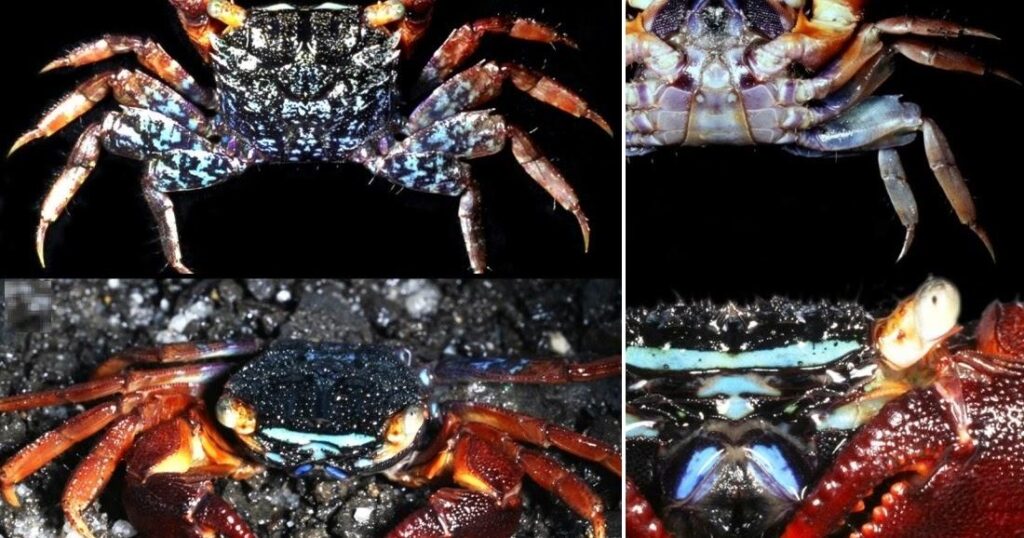Scientists have uncovered a remarkable natural adaptation in the mangrove crab species Parasesarma de Man, 1895: intricate light-focusing structures that function like tiny headlamps. This discovery, recently detailed in an article published by ESA Journals, sheds new light on how these crabs navigate their dimly lit, muddy habitats. By harnessing specialized biological optics, Parasesarma de Man crabs enhance their vision in low-light environments-a breakthrough that not only deepens our understanding of crustacean biology but also holds potential implications for bio-inspired optical technologies.
Nature’s Headlamps Illuminate Nighttime Mangrove Ecosystems
In the dim twilight of mangrove forests, Parasesarma de Man, 1895 crabs unveil a fascinating adaptation that turns night into an illuminated landscape. These crabs possess specialized eye structures that act as natural light concentrators, allowing them to navigate and forage efficiently amidst the dense shadows of mangrove roots. Unlike typical bioluminescence, their eyes employ a unique configuration of reflective surfaces that amplify ambient light, essentially functioning as biological headlamps. This adaptation gives them a distinct advantage in predator avoidance and resource detection during the nocturnal hours.
Recent studies published in ESA Journals highlight the intricate design of these ocular reflectors, revealing:
- Micro-lens arrays that enhance light gathering capacity
- Reflective tapetum layers that boost image contrast in low light
- Directional focusing mechanisms that reduce glare from surrounding water surfaces
This evolutionary innovation not only elevates the ecological role of Parasesarma crabs but also inspires biomimetic applications in night-vision technology. Below is a comparative overview of eye adaptations among nocturnal mangrove dwellers:
| Species | Light Amplification | Adaptation Type |
|---|---|---|
| Parasesarma de Man | High | Reflective microstructure |
| Sesarma reticulatum | Moderate | Enhanced pigment layers |
| Uca pugilator | Low | Simple compound eyes |
Unveiling the Unique Light Focusing Structure of Parasesarma de Man Crabs
Recent studies have revealed an extraordinary optical adaptation in Parasesarma de Man, a mangrove-dwelling crab species first described in 1895. These crabs possess a naturally evolved light-focusing structure embedded within their eyestalks, functioning much like miniature biological lenses. This arrangement enhances their nocturnal vision by concentrating available light into their photoreceptors, effectively turning their eyes into natural “headlamps.” What makes this structure particularly fascinating is its multilayered composition, which not only maximizes light capture but also minimizes chromatic aberration, ensuring sharp and vivid visual acuity in dimly lit mangrove environments.
Characterized by unique microstructures that resemble a series of concentric, curved prisms, the crab’s optical system presents several remarkable features:
- Gradient refractive indices: Layers gradually shift in density to focus light more efficiently.
- Biomineralized layers: These provide structural support while enhancing light transmission.
- Anti-reflective surface patterns: Minimizing glare and scattering during low-light foraging.
Below is a simplified comparison highlighting the differences between these biological structures and conventional optical lenses:
| Feature | Parasesarma de Man | Conventional Lens | |||||||||||
|---|---|---|---|---|---|---|---|---|---|---|---|---|---|
| Material | Organic biominerals & chitin | Glass or plastic | |||||||||||
| Refractive index | Parasesarma de Man and conventional lenses, or assist with summarizing the key points of your text. Just let me know how you’d like to proceed!
Harnessing Bioluminescence Insights for Mangrove Conservation StrategiesRecent studies reveal that Parasesarma de Man, 1895 mangrove crabs possess a remarkable bioluminescent mechanism, acting as natural headlamps to navigate the shadowy tidal zones. This unique light-focusing structure not only aids in foraging but also plays a pivotal role in predator avoidance, illustrating an evolutionary adaptation finely tuned to mangrove ecosystems. Conservationists are now exploring how these biological insights can inform habitat preservation efforts, particularly in enhancing light pollution regulation and maintaining the delicate balance of nocturnal mangrove environments. Key applications emerging from these findings include:
The Way ForwardAs researchers continue to uncover the remarkable adaptations of mangrove crabs like Parasesarma de Man, 1895, the discovery of their natural light-focusing structures offers exciting new insights into evolutionary innovation. These biological “headlamps” not only illuminate the shadowy mangrove environment but also open doors for biomimetic applications in optics and design. As the study published in ESA Journals highlights, nature’s ingenuity remains a powerful source of inspiration-shedding light on how even the smallest creatures have evolved extraordinary solutions to thrive in challenging habitats. |
